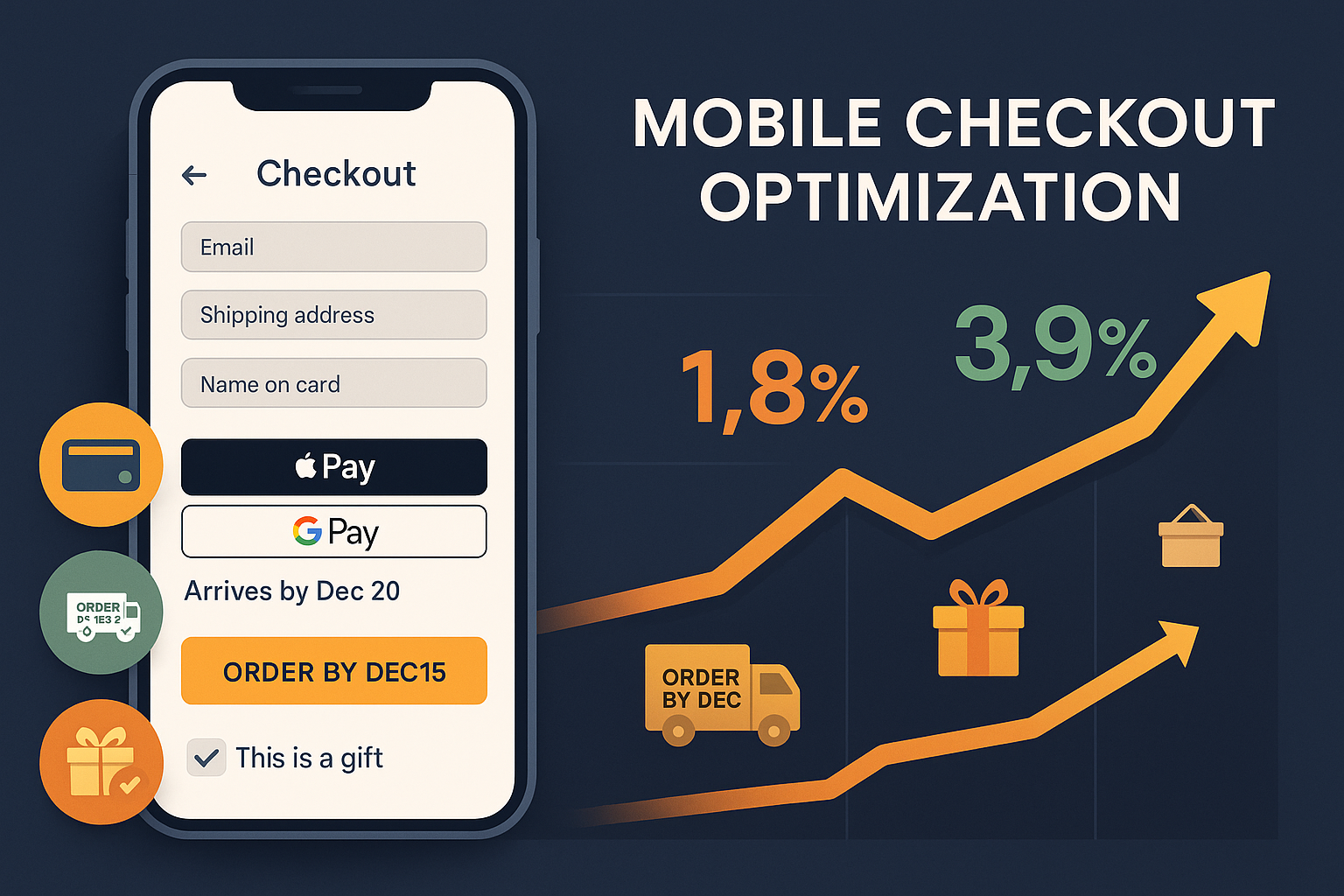Introduction
With Black Friday and Cyber Monday (BFCM) less than two months away, many merchants have their ads, inventory, and infrastructure lined up. But one conversion lever is too often overlooked - the mobile checkout experience.
Mobile traffic now dominates many stores, but mobile conversion rates tend to lag desktop significantly. According to recent data, desktop averages around 3.9% conversion, while mobile sits closer to 1.8% on many sites. MobiLoud
During peak holiday shopping, even small checkout friction becomes magnified: shoppers are distracted, time‑pressed, and less forgiving. In this post, you’ll find three core mobile checkout friction points that kill conversions—and tactical, realistic fixes (with notes on complexity) you can address before BFCM.
Why Mobile Checkout Optimization Must Be A Priority
- Traffic shifts strongly mobile. Many stores now see over 60–70% of visits come from smartphones during peak periods.
- Conversion gaps between devices remain. Mobile often converts at a lower rate - benchmarks suggest desktop leads by 1.5× or more. Smart Insights
- Holiday urgency exacerbates friction. A confusing form or ambiguous shipping promise that might be tolerated in low season becomes a deal-breaker during BFCM.
- Gift psychology raises buyer expectations. Shoppers want clarity: “Will it arrive in time? Is it gift-wrapped? Can I personalize it?” Uncertainty reduces trust and increases abandonment.
Friction Point #1: Overly Complex Forms & Poor Input Design
Why It Hurts
- Mobile keyboards can cover half the screen, making field context invisible
- Switching input types (letters, numbers, symbols) slows entry
- Autocorrect errors, mis-taps, and long scrolls frustrate users
- Every extra required field increases risk of abandonment
Realistic Fixes (With Implementation Notes)
1. Reduce Required Fields to the Essentials
Only ask for data absolutely needed for fulfillment and fraud detection. Move noncritical info to a post‑purchase upsell or account setup step. Guest checkout is ideal.
2. Use Address Autocomplete / Suggestions
Leverage your platform’s built-in address suggestions or plugins.
3. Correct Input Types & Tap Targets
Set field types so mobile devices trigger the correct keyboards. Make tap targets at least ~44px tall.
4. Consider Auto‑Advance or Smart Field Behavior (Optional)
Example: auto-advance after ZIP entry. Requires plugins or theme support.
5. Keep Labels Visible & Inline Help
Use floating labels or visible headers. Add format hints to reduce confusion.
Friction Point #2: Limited Payment Options
Why This Breaks Conversions
- Holiday shoppers expect one-tap convenience—wallets, BNPL, gift cards
- Missing preferred payment methods leads to instant abandonment
- Baymard reports ~9% of abandonment is due to payment method issues
Tactics You Can Apply
1. Enable Mobile Wallets
Activate Apple Pay and Google Pay for fast checkout.
2. Support Multiple Alternatives
Include PayPal, credit cards, BNPL (Klarna, Afterpay), and gift cards.
3. Display Payment Logos Early & Clearly
Show accepted logos before checkout begins.
4. Fallback Logic & Smart Defaults
If one method fails, suggest alternatives without restarting checkout.
Note on Implementation Complexity:
Advanced logic may require plugins or theme dev work.
Friction Point #3: Shipping Ambiguity & Deadline Anxiety
Why It Kills Sales
- Customers need to know gifts will arrive on time
- POD adds production time - must be clearly stated
- “7–10 days” doesn’t inspire confidence - use dates
Tactics That Work
1. Show Concrete Delivery Dates
Use “Arrives by Dec 20” instead of timeframes.
2. Use Dynamic Deadline Banners
Example: “Order by Dec 15 for Christmas delivery.” Update weekly.
3. Offer Multiple Shipping Speeds
Display options side-by-side with price and ETA.
4. Gift Settings Made Easy
Add a checkbox for “This is a gift” with messaging options.
5. Display Production Time Clearly
Include production time in delivery estimate text.
Implementation Note:
Dynamic delivery date logic may require a plugin.
Testing Protocol: Don’t Wait Until BFCM
Device & Network Testing
- Test on real iPhones, Androids, tablets
- Check performance over WiFi, 4G, and slow connections
Full User Journeys
- Guest checkout
- Returning users
- Gift orders
- Declined cards, address errors
Error & Edge Case Handling
Trigger known issues and ensure mobile-friendly error messages appear.
Load / Stress Tests
Simulate high-traffic checkout to catch slowness or breakdowns.
Metrics to Monitor & Improve
- Mobile Conversion Rate — primary success signal
- Abandonment by Step — shows where users drop
- Checkout Completion Time — target: under 90 seconds
- Payment Method Usage — wallet/BPNL adoption rate
- Form Error Rate — find which fields confuse users
- Customer Support Volume — watch for shipping/payment complaints
Common Mistakes & Pitfalls
- Removing too many fields (hurting fraud prevention)
- Assuming desktop UI will “just work” on mobile
- Making last-minute changes during BFCM week
- Neglecting performance (page speed, caching)
8‑Week Action Plan
| Weeks | Focus | Tasks |
|---|---|---|
| 1–2 | Form Simplification | Reduce fields, enable autocomplete, improve inputs |
| 3–4 | Payment & Shipping | Add wallets, BNPL, delivery banners |
| 5–6 | UX Polish | Add gift flows, error handling, fallback payment logic |
| 7–8 | Testing & Stabilization | Device testing, stress testing, bug fixing |
Final Thoughts
Mobile checkout matters more than ever during BFCM. Each friction point you remove (fields, payment limits, shipping uncertainty) is money saved—and conversions gained.
Start with the area that’s hurting your store most. Implement, test, measure, and enter BFCM with confidence.


